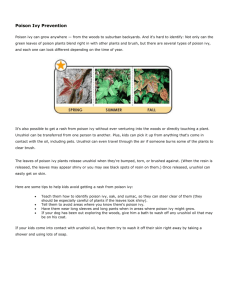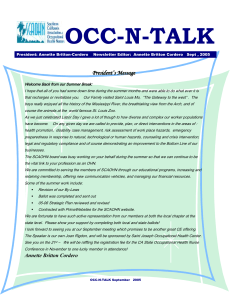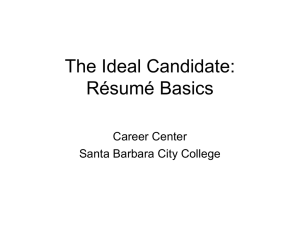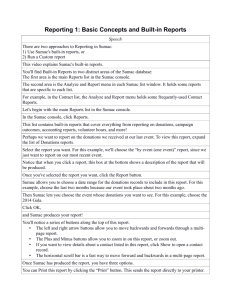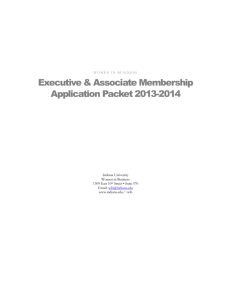WEX Safety Training - Workforce Investment Board
advertisement
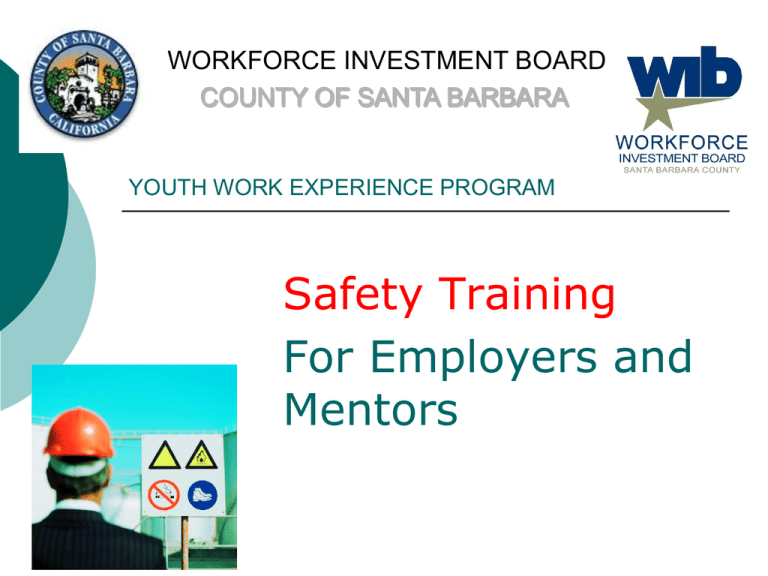
WORKFORCE INVESTMENT BOARD COUNTY OF SANTA BARBARA YOUTH WORK EXPERIENCE PROGRAM Safety Training For Employers and Mentors Table of Contents Ergonomics Movement and Physical Demands Lifting and Carrying Heat Stress Poison Ivy, Oak, and Sumac Earthquakes Injury and Illness Prevention WORKFORCE INVESTMENT BOARD COUNTY OF SANTA BARBARA YOUTH WORK EXPERIENCE PROGRAM Safety Training Movement and Physical Demands -Ergonomics- Ergonomic Guidelines ♦ Keep it Natural ♦ The Next Position is the Best Position Do’s Keep arms at your side Keep your wrists flat Monitor at arms length Take regular breaks Sit with good posture Move eyes away from monitor every 15 minutes for a few seconds Stay healthy on the job ! Ergonomic Guidelines ♦ Keep it Natural ♦ The Next Position is the Best Position Do’s Stretch shoulders, elbows, wrists, and fingers before, during and after work Use smooth, efficient motions – muscles and joints don’t like surprises. Keep the space below and around the desk clear of obstruction Keep the top of the screen at 0 to 60 degrees below horizontal, at eye level Ergonomic Guidelines ♦ Keep it Natural ♦ The Next Position is the Best Position Do’s Keep the keyboard and mouse at elbow height and at a comfortable distance from your body Ensure you have additional support for your back, feet, wrist, etc. Ergonomic Guidelines ♦ Keep it Natural ♦ The Next Position is the Best Position Don’ts Reach for heavy items Cradle your phone Pull your chair around Keep working if it hurts Be afraid to ask for help Use an awkward work position that strains the body Hit the keys too hard Bend your wrist, while typing for any lengthy period of time Printers, Copiers and Electrical Equipment Don’t use any machine that you have not been trained, instructed, or authorized to use. Call trained personnel to clear jams in copiers and other machinery Report malfunctions or potentially unsafe conditions to your supervisor Be alert for electrical hazards Personal Protective Equipment (PPE) Request PPE from your WIB caseworker and/or worksite supervisor to prevent potential injuries or illnesses. Use PPE around machinery or other equipment as instructed. Your Safety Your safety is our number one priority. Report any safety hazards immediately to your Site Mentor and/or the Program Coordinator at phone number 805478-5536. WORKFORCE INVESTMENT BOARD COUNTY OF SANTA BARBARA YOUTH WORK EXPERIENCE PROGRAM Safety Training Movement and Physical Demands -Fall Prevention- Fall Prevention •Keep file and desk drawers closed when not in use •Keep floors clean – even a pencil or paperclip may cause a slip, trip, or fall •Use aisles and avoid between-desk short cuts. Wastebaskets, phone, and extension cords are waiting to trip someone. •Watch your step. Do not read or use a cell phone/radio while walking nor obstruct your vision with loads in your arms. •Report burned out lights promptly http://www.youtube.com/watch?feature=endscreen&v=7oHKMDnEJ6I&NR=1 Fall Prevention (continue) Don’t lay extension cords across roadways or other areas where they may be run over by vehicles or other moving objects. Inspect cords for broken insulation before use. Excessive scraping, kicking and stretching will damage power cables and cause premature failure Ground wires or prongs leading from electrical apparatus must be disconnected Consider all electrical wires “live” until proven otherwise Fall Prevention (continue) Office work areas should be kept free of loose electric and telephone wires. Pull the plug instead of yanking the cord. Never remove a cord if it is in use. Electricity can jump across exposed prongs in the plug. Have approved fire extinguishers in appropriate areas for electrical fires. Fall Prevention (continue) Turn off the power, unplug, tag, and report overheating, sparking or smoking motors, wiring, and other electrical equipment to your supervisor. Don’t use broken equipment Never put your hands inside an electrical panel while the main power is still on. Ensure all office machines are grounded with the three-prong plug or be of the double insulated type before use. WORKFORCE INVESTMENT BOARD COUNTY OF SANTA BARBARA YOUTH WORK EXPERIENCE PROGRAM Safety Training Movement and Physical Demands -Lifting and Carryinghttp://www.youtube.com/watch?v=NgKEidZynf M Lifting and Carrying Lifting •Size up the load, its position, and surrounding hazards. Get help, if needed. •Stand as close to the load as possible and spread your feet, either parallel or one in front of the other. Face in the direction of the lift. Widen base as needed to control your center of gravity and give you better balance. •Take a secure grip, but keep fingers away from pinch points. Wear protective gloves as necessary. Lifting and Carrying Lifting (continue) With knees and hips bent, tighten abdominal muscles, breathe, and lift. Keep load and elbows close to the body. Use legs and hip muscles, and not the back, while maintaining the back’s natural curves. When reaching for an object overhead, grip it with palms up and lower the object slowly. On the way down, keep the object close to the body. Watch out for protruding objects, sharp edges, etc. Use available hand trucks, carts, etc. Lifting and Carrying Carrying Keep load close to the body and centered over your pelvis, while maintaining the back’s natural curves whenever possible. Counterbalance your load by shifting the part of your body in the opposite direction from the load so your load will be in balance. With the load close to the body, set it down by bending the hips and knees with the back in a “neutral” position while holding the back’s natural curves. If the load is too heavy, get help. When the load is carried by more than one person, allow one individual to be the leader for good timing and coordination. WORKFORCE INVESTMENT BOARD COUNTY OF SANTA BARBARA YOUTH WORK EXPERIENCE PROGRAM Safety Training Movement and Physical Demands -Heat Stresshttp://www.youtube.com/watch?v=cR6FA5w8A1o Heat Stress Prevention Program Outdoor Temperature & Clothing Action Levels This program applies when WIB Youth participants are exposed to outdoor heat at or above the following temperature and clothing action levels. All other clothing 89° F Double-layer woven clothes including coveralls, jackets and sweatshirts 77° F Non-breathing clothes including vapor barrier clothing or PPE such as chemical resistant suits 52° F Heat Stress Prevention Program It is possible for outdoor heat related illness to result at temperatures below the action levels when WIB Youth participants have not acclimatized to sudden and significant increases in temperature and humidity. Worksite Supervisors and WIB Youth participants should monitor for signs and symptoms of outdoor heat related illness when there is a significant and sudden increase in temperature. Heat Stress Prevention Program WIB Youth participants are responsible for monitoring their own personal factors for heat related illness including consumption of water or other acceptable beverages to ensure hydration. Evaluating and Controlling Outdoor Heat Stress Factors In addition to outdoor temperature, worksite supervisors should evaluate other potential heat stress factors. These factors include: Radiant Heat (Example: reflection of heat from asphalt, rocks, or composite roofing material, or work in direct sunlight) Air Movement (Example: wind blowing and temperature above 95° F) Workload Activity and Duration (Examples: hand sawing, digging with a shovel) Personal Protective Equipment (Examples: wearing a respirator, chemical resistant suit and gloves for pesticide application, or leathers and gloves for welding) Evaluating and Controlling Outdoor Heat Stress Factors Taking breaks in a shaded area (building, canopy and under trees) Starting the work shift early (when daylight begins) and ending the shift early and/or not working outside during the hottest part of the day. Removing personal protective equipment such as respirators, chemical resistant clothing and gloves, and welding leathers during breaks Using cooling vests or headbands Evaluating and Controlling Outdoor Heat Stress Factors Drinking Water Sufficient quantity of potable drinking water will be provided and made accessible to WIB Youth participants. At least one quart of water per employee/student per hour will be available. Water will be provided at the individual worksite. Evaluating and Controlling Outdoor Heat Stress Factors WIB Youth participants experiencing signs and symptoms of a heat-related illness are to cease work and report their condition to their Worksite Supervisor. WIB Youth participants showing signs or demonstrating symptoms of heat-related illness are to be relieved from duty and provided sufficient means to reduce body temperature. WIB Youth participants experiencing sunburn, heat rash or heat cramps will be monitored to determine whether medical attention is necessary. Emergency medical services will be called (911) when WIB Youth participants experience signs and symptoms of heat exhaustion or heat stroke. Heat-Related Illness First Aid and Emergency Response Procedures HeatRelated Illness Signs and Symptoms First Aid and Emergency Response Procedures Move Sunburn Red, hot skin Possibly blisters Red, Heat Rash itchy skin Bumpy skin Skin infection Muscle Heat Cramps cramps or spasms Grasping the affected area Abnormal body posture to shade, loosen clothes Apply cool compress or water to burn Get medical evaluation if severe Apply cool water or compress to rash Keep affected area dry Drink water to hydrate body Rest in a cool, shaded area Massage affected muscles Get medical attention in cramps persist Heat-Related Illness First Aid and Emergency Response Procedures Heat-Related Illness Heat Exhaustion Heat Stroke Signs and Symptoms First Aid and Emergency Response Procedures High pulse rate Extreme sweating Pale face Insecure gait Headache Clammy and moist skin Weakness Fatigue Dizziness CALL Any CALL of the above, but more severe Hot, dry skin (25-50% of cases) Altered mental status with confusion and agitation Can progress to loss of consciousness and seizures 911* Provide EMS with directions to worksite Move to shade and loosen clothing Start rapid cooling with fan, water mister or ice packs Lay flat and elevate feet Drink small amounts of water to hydrate and cool body 911* Provide EMS with directions to worksite Immediately remove from work area Start rapid cooling with fan, water mister or ice packs Lay flat and elevate feet If conscious give sips of water Monitor airway and breathing, administer CPR if needed Heat Related Illnesses Sunburn Heat Rash Heat Cramps Heat Stroke Heat Exhaustion WORKFORCE INVESTMENT BOARD COUNTY OF SANTA BARBARA YOUTH WORK EXPERIENCE PROGRAM Safety Training -Poison Ivy, Oak, or Sumac Preventionhttp://www.youtube.co m/watch?v=nDQV61cN KsU Poison Ivy, Oak, or Sumac Prevention Only the oil (urushiol) from poison ivy, oak, or sumac plants can cause a rash (allergic contact dermatitis ). The best way to avoid contact with urushiol and getting a rash is to avoid the plants. Poison Ivy, Oak, or Sumac Prevention Learn to recognize these plants, especially those near where you live. The plants may look different depending on the season and the area where they are growing. A county agricultural extension service may be able to help you identify the plants in your area. See a picture of poison ivy, oak, and sumac leaves . While their appearance changes with the seasons, the plants usually contain the same amount of urushiol year-round, even in the winter when they only appear as bare sticks. Black areas on the plants may help you identify them in the winter (urushiol turns black when exposed to air). Living, dormant, and dead plants all contain urushiol, although dead leaves do not contain a lot of it. Poison Ivy, Oak, or Sumac Prevention You may try to remove the plants when appropriate. Never handle these plants without vinyl gloves (urushiol can penetrate rubber). When you cannot avoid being near poison ivy, heavy clothing (long pants, long sleeves, enclosed footwear) may help prevent the oil from touching your skin. Clothing or any other object that has touched the plant must be handled carefully and washed thoroughly. Poison Ivy, Oak, or Sumac Prevention If you are often in areas where poison ivy, oak, or sumac grows, you may want to get a product (such as Tecnu or Zanfel) that is designed to remove the plant oil (urushiol) from your skin. Barrier creams and lotions can be used to prevent urushiol from contacting the skin or to reduce the severity of a reaction. These creams vary in their potency and are not always effective. Poison Ivy, Oak, or Sumac Prevention If you suspect that your skin has touched poison ivy, oak, or sumac, rinse the area with water immediately (within 10 to 15 minutes) to help prevent a reaction. Most of the oil is absorbed into the skin within 30 minutes.1 Clothing should also be thoroughly washed right away. Contaminated surfaces should be cleaned with rubbing alcohol. WORKFORCE INVESTMENT BOARD COUNTY OF SANTA BARBARA YOUTH WORK EXPERIENCE PROGRAM Safety Training -Earthquakes- Earthquakes During an Earthquake •Don’t panic or run •If Indoors, stay there and take cover under a sturdy desk, table, etc. •Stay away from windows •Watch for falling plaster, ceiling tiles, light fixtures, pictures, mirrors, free standing file cabinets or equipment. •If outside, stay there. Stay away from buildings, poles, television aerials, roof ornaments, chimneys, high walls, glass, and power lines. •If in a vehicle, pull over and stop in an open area away from bridges, overpasses, power lines, buildings, and other hazards. Stay in the car until the earthquake is over. •In an earthquake, the elevators should go to the next floor and stop, and the doors should open. Get off and move to a safe place. Don’t stay in the elevator http://www.youtube.com/watch?v=dLWN7AHftBo&feature=related Earthquakes After an Earthquake Check for injured or missing people. Obtain medical aid, if necessary. When it is safe to leave the building, move carefully to the prearranged staging area. Do not reenter damaged buildings until the buildings have been declared safe. If a building is damaged, do not use electrical equipment or matches. Don’t use telephones and cellular phones, they will be needed for emergency communications. If in a vehicle, watch for earthquake caused hazards (e.g. fallen or falling objects, downed electrical wires, or broken or undermined roadways). Don’t cross or pass under bridges or overpasses unless reasonably sure it is safe to do so. Be prepared for aftershocks over the next days and weeks. Earthquakes Preparedness Learn how to use fire extinguisher and how to administer first aid Consider how to protect yourself and make the office safer Don’t keep heavy objects or unstable materials on high shelves Glass and other breakables should not be stored on high shelves Plan how and where to meet your family if not at home when an earthquake strikes. WORKFORCE INVESTMENT BOARD COUNTY OF SANTA BARBARA YOUTH WORK EXPERIENCE PROGRAM Safety Training -DSS Injury & Illness Prevention Program DSS Injury and Illness Prevention Program (IHPP) The DSS IHPP was created to prevent employees personal injury and to protect all employees from unnecessary and foreseeable work hazards, including the public insofar as they come into direct contact with DSS operations and services. Where to Obtain More Information To Receive a Full Copy of the IIPP Manual, Contact Your Local WIB Office Santa Maria: 2125 S. Centerpointe Parkway Santa Maria, 93454 Phone: 614-8245 Contact: Michelle Lynch Lompoc: 118 North H Street Lompoc 93436 Phone: 896-6835 Contact: Angela Olmos Santa Barbara: WIB Administration 260 North San Antonio Rd. Suite C, Santa Barbara 93110 Phone: 681-4453 Contact: Luis Servin
